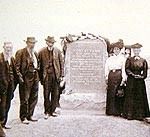Our History
The history and heritage of Platteville taken from the Platteville Comprehensive Plan with information from the Platteville Pioneer Museum.
Location and Origins
Platteville, one of the oldest communities in Weld County, occupies land that was once the hunting grounds of nomad tribes and Cheyenne Indians. It is located along the banks of the South Platte River and enjoys a rich history vital to the development of the region. Platteville, Colorado was founded in 1871, after the Denver Pacific Railroad reached the area.
Platteville's origins are traced back to Fort Vasquez, an important 1830’s fur trading post. The Platte River's fertile valley has long been known for its livestock and poultry, with over 200 farms now located in the surrounding area.

Regional Trading Forts
Fort Vasquez
The history of settlers to the area goes back to the establishment of fur trading forts along the South Platte. The first of the forts, Fort Vasquez, located about one mile south of current day Platteville, was built in 1835 by Louis Vasquez and Andrew Sublette.
Fur Trading
By 1837 Fort Lupton, Fort Jackson, and Fort St. Vrain had all been established and enjoyed a period of brisk trade with the Native Americans, who brought hides and pelts to the fort in exchange for blankets and pots and pans, but also for whiskey, silk handkerchiefs, and ivory combs. The days of the fur trade soon came to an end, and by 1845 the forts had been abandoned.
Fort Vasquez Renovation
With efforts by the WPA, citizens, and the State Historical Society, the late 1930’s brought extensive renovation at Fort Vasquez, which today stands as an historic landmark providing glimpses back to those early days.
Gold Rush
Arrival of First Settlers The Colorado Gold Rush of 1857 brought hordes of people through the area. The first settlers began arriving in 1859 and eventually set up a seat of government at St. Vrain, about four miles north of the present site of Platteville. St. Vrain was designated the county seat in 1861 when Weld County was first established with the creation of the Colorado Territory. That center of government lasted until 1868.
Founding of Platteville
Johnson Station
The real development of the land along the South Platte River began with the completion of the Denver and Pacific Railroad line from Evans to Denver in 1870. Johnson Station was established two miles south of the present Town of Platteville.
Platte River Land Company
The Platte River Land Company formed a town site and filed a map of the Town of Platteville with the Colorado Territorial government on July 17, 1871. Officers of the company were:
- Benjamin F. Johnson, president
- General John Pierce, vice-president
- Mr. William Byers, secretary
Mr. Johnson was an insurance man from Chicago, General Pierce was an officer of the Denver Pacific Railroad, and Mr. Byers was founder of the Rocky Mountain News. Colonel C. N Pratt was in charge of obtaining transportation for colonists, James Cherry of Chicago was geologist, and consulting engineer, Albert Johnson of Georgetown was surveyor and Avery and Goodrich of Chicago were agents for the sale of lots.
The auction of lots was held in Chicago and New York City. Many of the buyers held on to their land for several years but only a small number of them actually settled in the Town.
Frontier Town
Early Development During those early years, Platteville was described as a “hustling little frontier town”. Platteville’s first general store was established in the late 1870’s and contained the store, post office, and a small hotel.
Some of the other early businesses included an ice house, a cheese factory, and a brick factory. By 1910 Platteville boasted four general stores, two banks, two bakeries, two barber shops, two butcher shops, two blacksmith shops, two weekly newspapers, two hotels, one drug store, one cobbler shop, and one clothing and dry goods store.
The town served people from all the surrounding valleys: St. Vrain, Big and Little Thompson, and ranchers on the eastern Great Plains. The Methodist Church was the first to be built in 1871, soon followed by St. Nicholas Catholic Church.
